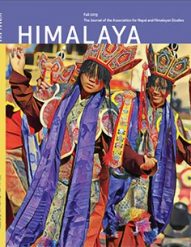Photo Essay
A Bonpo Mendrup Celebration in Kathmandu, 2012: How Potency is Accomplished
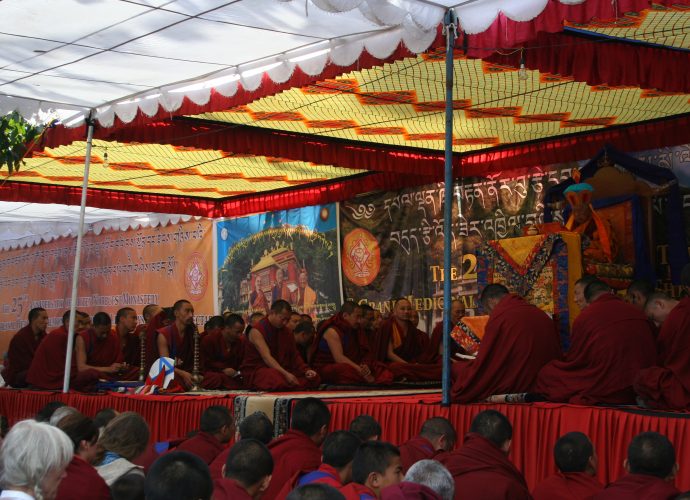
Yongdzin Tendzin Namdak Rinpoche gives the empowerment of the Light-Swirled Mendrup performance to the gathered assembly of monks and lay participants at Triten Norbutse in 2012. Yongdzin Rinpoche supervises the entire mendrup ritual and leads the congregation through the most important parts of the rite. All the necessary empowerments are bestowed by him. Yongdzin Rinpoche also presides over the concluding celebration of distributing the accomplished mendrup medicine. This rare event is attended by about one thousand people, all of whom wish to obtain at least a little of the precious mendrup substance.
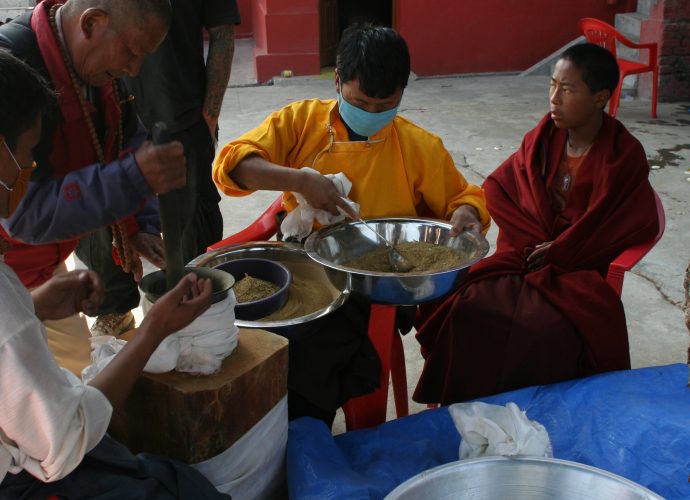
The ritual grinding of the mendrup medicine continues until late afternoon. Amchi Nyima (second from right) and Namsé (far left, in white shirt) direct the mendrup participants in beating the mendrup medicine in the mortar. A visiting practitioner from Himalayan Bonpo communities is just taking part at the pestle (second from left), being watched by a Western Bonpo follower who has already had his turn (third from left). Amchi Nyima pours the raw ingredients into the mortar with a ladle. He then sieves the ground mixture so that only fine powder constitutes the final empowered mendrup medicine. A young monk (first from right) keeps them company during the grinding. Once the grinding is completed, the mendrup medicine is returned to the mandala of the ritual in the center of the assembly hall.
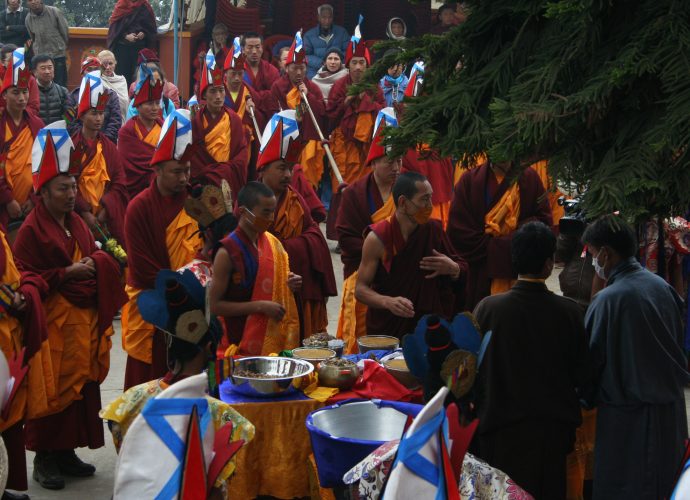
The medicinal vessels containing ground and unground ingredients are laid out on the table in front of Amchi Nyima (second from right) and Namsé (right). Monks accompany the act with ritual music and recitations.
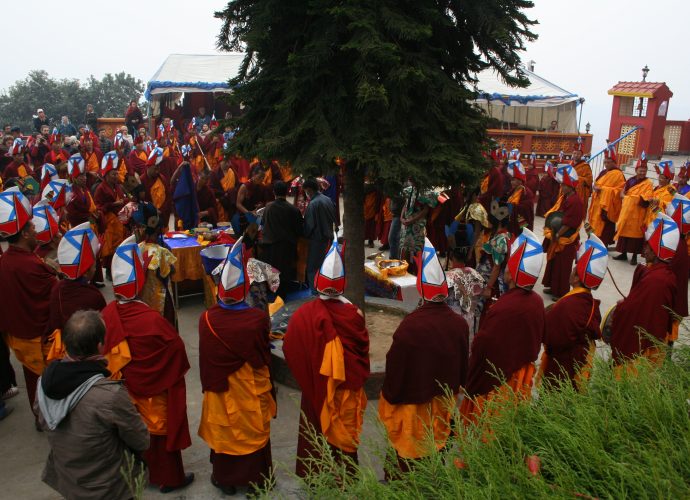
A scene from the ritual grinding of the mendrup medicine. Amchi Nyima and his main disciple Namsé (Gnam gsas, also Gnam sras) are standing in the centre (under the tree) and pour the contents of the medicinal vessels into a mortar. All members of the congregation symbolically take part in the task and beat the substances three times with a pestle. Despite the high number of participants, most of the hard work is done by Amchi Nyima and Namsé.
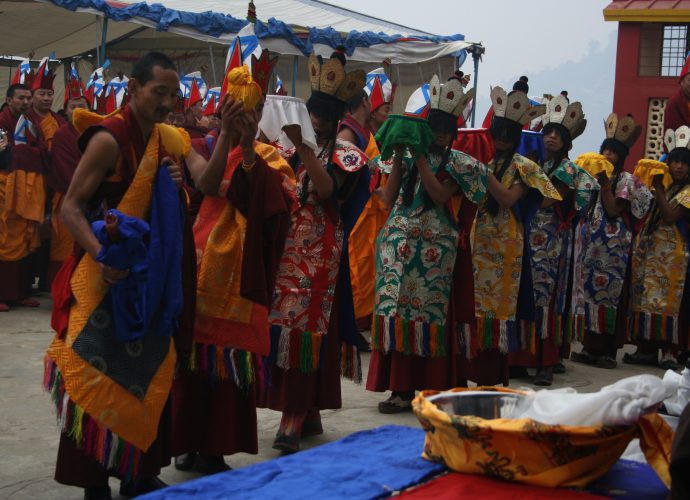
On the fifth day of the fifteen days-long-ritual action, the Eight Goddesses carry the mendrup medicine vessels out of the mandala and the assembly hall to perform the grinding of the medicine. The procession is led by an honorable monk carrying the precious container of the papta (phabs gta’) or ‘fermenting agent,’ which is wrapped in yellow cloth. He is then succeeded by a monk carrying the white vessel of the Centre, followed by the vessels of the East, North, West, and South, according to the Bonpo anticlockwise order. Then come the vessels of the intermediate cardinal directions (Northeast, Northwest, Southwest, and Southeast). Since all of them are in yellow color, their sequence is not distinguishable. The large metal container visible in the front is ready for grinding.
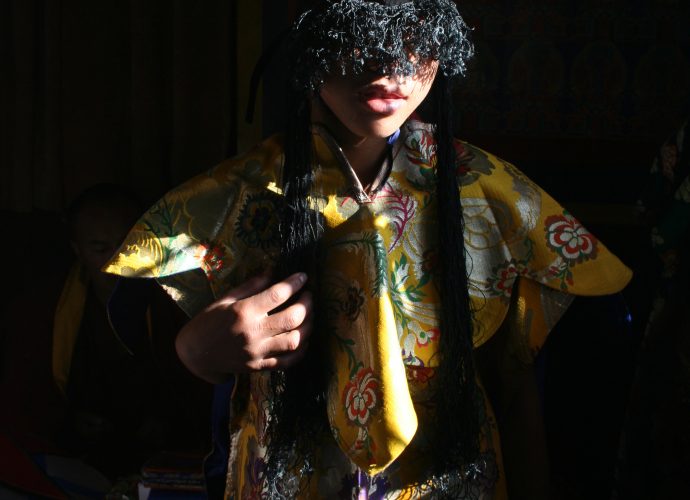
A monk enacting one of the Eight Goddesses readies himself for the ritual performance, having placed the five-corner crown (rigs lnga) on his head. The costumes are made of artificial brocade cloth in the five colors of the cardinal points, which are in accordance with the five colors of the mandala and the mendrup medicinal vessels: white, yellow, green, red, and blue. The five colors represent the five Buddha families (rgyal ba rigs lnga, see Table 1 in Sehnalova 2019), which are also symbolized by the five-pointed crown. Long black hair is affixed to the crown and covers the monk’s eyes. The hair is supposed to assemble the power of the divine realms. Its black color signifies changelessness and stability (mi ’gyur ba), since black itself cannot be changed by other colors.

All the vessels are placed on a sheet of glass right above the mandala along with various offerings to the deities invoked. In the photograph, the white vessel of the Centre and the yellow vessels of the intermediate points can be seen. The five-colored ‘spell cord’ strings lead from the mandala to the throne of the presiding performer of the ritual, the abbot of the monastery. The cord transmits the powers and blessings of the deities summoned by the practitioners to the mendrup mandala and into the medicine.
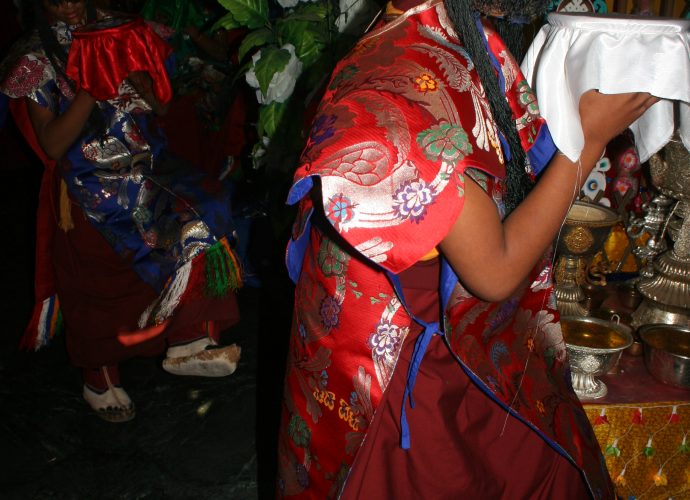
Once the mandala is installed at the centre of the main assembly hall of the monastery, its structure is sealed and forbidden to be opened. The ‘Eight Goddesses,’ played by young monks dressed as goddesses, perform a vivid dance in the Bonpo anticlockwise direction around the mandala, during which they place the mendrup medicinal vessels on the mandala. In the front appears the ‘Goddess’ holding the white bowl representing the Centre.
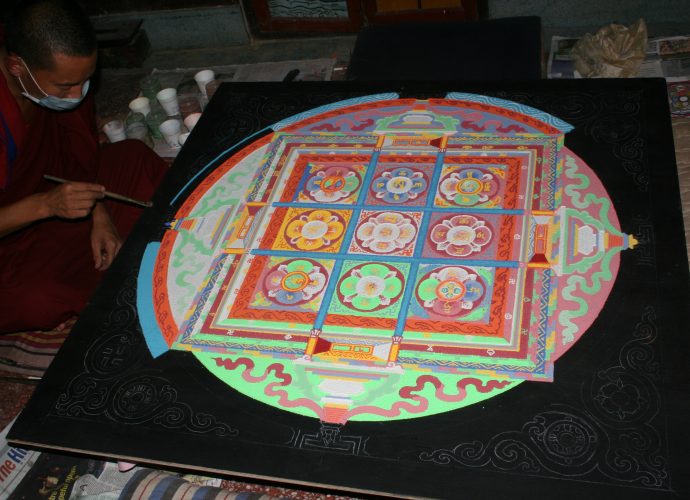
The main mendrup mandala is prepared from different types of colored sand on a wooden board. Its cardinal points with the distinctive colors are clearly visible. The mandala represents the palace of the tutelary deity Trowo Tsochok Khagying and his retinue. The nine squares stand for the distinct quarters of the divine palace and the divinities that occupy them.
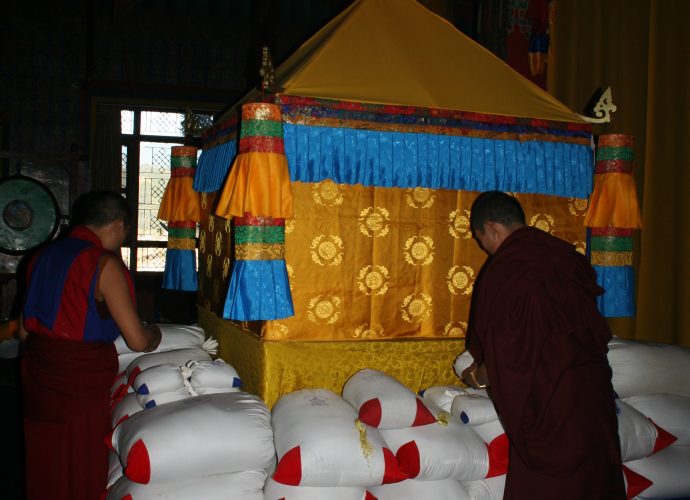
All the mendrup medicine bags are then arranged around and below the special ritual structure containing the mendrup mandala. The structure is of yellow color. Here, the blue color of the cardinal direction of the South is visible, as well as some of the red color of the West. Monks are organizing the small and large bags of the mendrup medicine around the mandala.
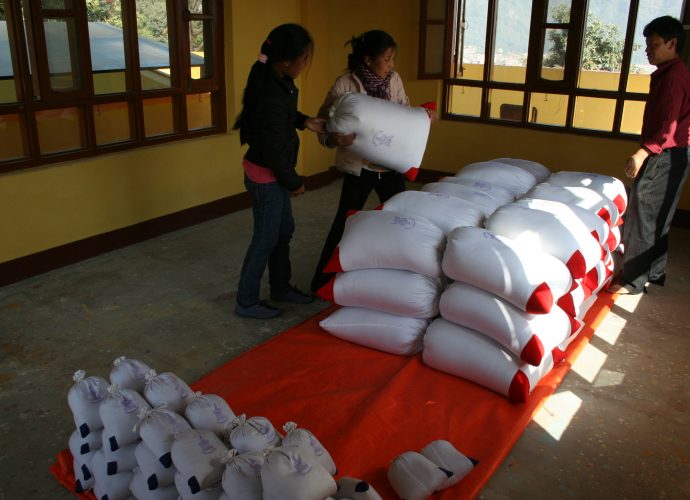
About one thousand kilograms of the mendrup medicine have been produced in preparation for the ritual, and packed in cotton bags used for keeping Sowa Rigpa drugs at the monastery’s medical clinic. Amchi Nyima has been organizing and carrying out the work, supported by his students. Different sizes of bags are chosen for different recipients of the medicine: large bags are sent to other Bonpo monasteries and also kept at Triten Norbutse, middle-sized bags are prepared for the sponsors of the ritual. The amount of the mendrup medicine cannot fit into the medicinal vessels placed on the mandala, and thus will remain in bags also for the duration of the ritual.

The medicinal vessels of the five cardinal points are covered with cloth lids of their respective signs and colors: the white cloth with a swastika will occupy the Centre, the green with a dharma wheel the North, the red embellished with a lotus flower will represent the West, and the blue with a flaming jewel the South. The yellow cloth covered bowl representing the East is missing in the photograph.
![The vessels of the five cardinal points are filled with raw medicinal ingredients. The photograph shows some of them: white sugar (ka ra, one of the ‘three sweet [substances],’ mngar gsum), kaolin (cu gang), safflower (bal gur gum), cinnamon, as well as smaller (sug smel) and greater cardamom (ka ko la). A few ingredients, such as the ‘three sweet [substances]’ and cinnamon visible here, were included as additional substances according to the oral instructions of Yongdzin Rinpoche. They are not found in the mendrup recipe.](../../wp-content/uploads/2019/07/4-1-690x500.jpg)
The vessels of the five cardinal points are filled with raw medicinal ingredients. The photograph shows some of them: white sugar (ka ra, one of the ‘three sweet [substances],’ mngar gsum), kaolin (cu gang), safflower (bal gur gum), cinnamon, as well as smaller (sug smel) and greater cardamom (ka ko la). A few ingredients, such as the ‘three sweet [substances]’ and cinnamon visible here, were included as additional substances according to the oral instructions of Yongdzin Rinpoche. They are not found in the mendrup recipe.
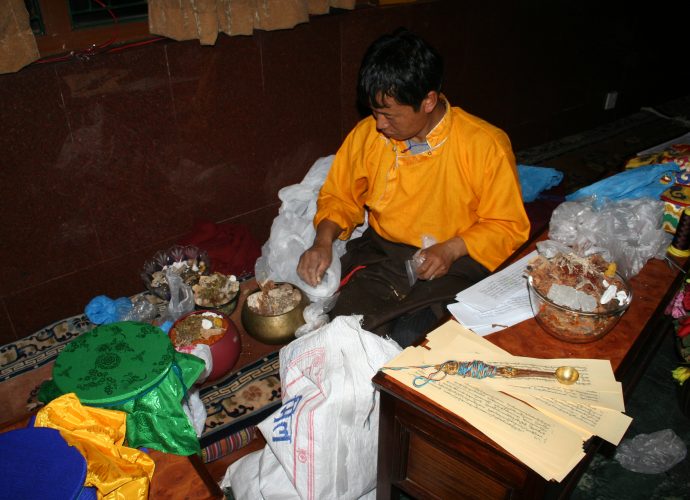
Amchi Nyima is mixing the raw ingredients and filling the cardinal medicinal vessels to be placed upon the mendrup mandala during the ritual. He closely follows the photocopied manuscript of the mendrup medicinal formula which lists more than one hundred ingredients and is placed on the table in front of him. Amchi Nyima is including all of those herbal ingredients that he can comprehend from the formula, as well as a few minerals and one animal substance (red lac). Nevertheless, he skips the part of the recipe listing animal and human body parts. The colorful ritual ‘spell cord’ (byang thag, gzungs thag) is wrapped around a ceremonial brass ladle. The spell cord has five strings in the five colors of the cardinal directions. The cord connects the abbot presiding over the ritual with each point on the mandala and its medicinal vessel (see below). The ladle will be used for liquid offerings to the deities invoked.
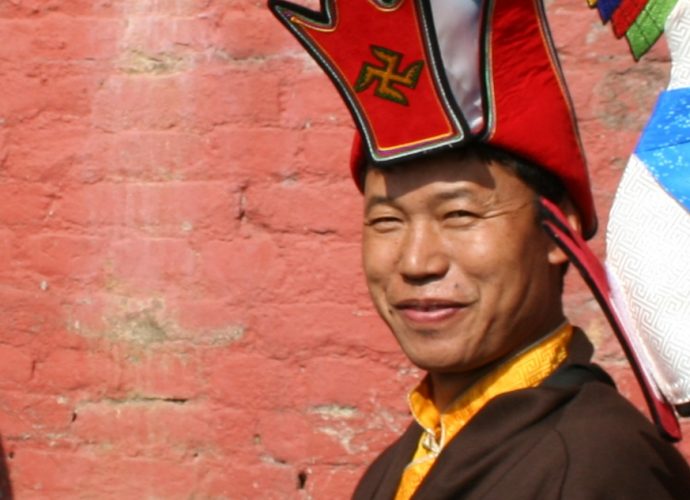
Amchi Nyima, the main Sowa Rigpa practitioner of the monastery, who was assigned the task of compounding the mendrup medicine. He is wearing the typical Bonpo white-blue hat with the auspicious sign of the left-turned swastika (dkar mo khyung gshog). Here, he is taking part in a procession which formed a part of the mendrup ritual.
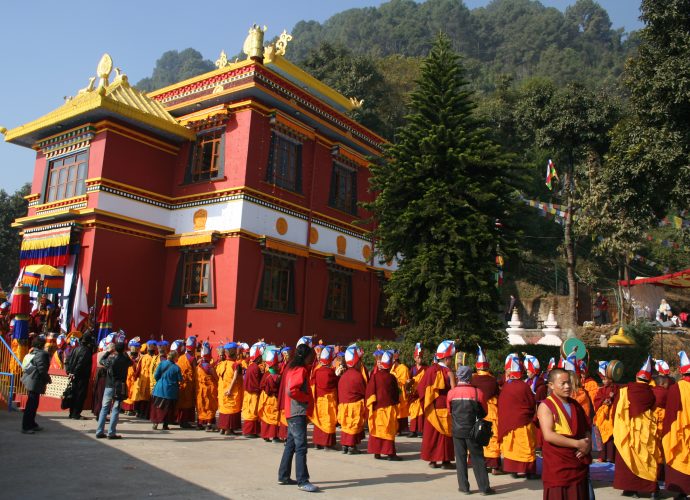
Triten Norbutse monastery in December 2012 during the Light-Swirled Mendrup celebration. A ceremonial procession of monks leads to one of the venues within the monastic compound where the individual parts of the ritual were performed. About one thousand people witnessed and took part in the ritual, and, most importantly, received the consecrated mendrup medicine.
by Anna Sehnalova
Once every several years, the Bonpo Triten Norbutse (Khri brtan nor bu rtse) monastery in Kathmandu, Nepal, enjoys a long-awaited celebration – the mendrup (Tib. sman sgrub; ‘medicinal accomplishment’) ritual, or the great ‘medicinal accomplishment.’ The last mendrup took place in December 2012 and is visually documented in this photo essay. Triten Norbutse monastery, established in 1992 (initiated in 1986), represents the second-most important center of the Tibetan Bonpo (bon po) religious school in exile, after Tashi Menri (Bkra shis sman ri) monastery in India. In 2012, Triten Norbutse was home to about two hundred monks. It is lead by Yongdzin Tendzin Namdak Rinpoche (Yongs ’dzin Bstan ’dzin rnam dag rin po che, born 1926, Tibet) and the incumbent abbot Khenpo Tenpa Yungdrung (Mkhan po Bstan pa g.yung drung, born 1969, Nepal). The monastery traces its roots back to the original and preeminent Bonpo Tashi Menri monastery in Central Tibet.
The mendrup ritual has been preserved among other traditions of Tashi Menri, both through its scriptures and in accompanying oral explanations. Yongdzin Tendzin Namdak Rinpoche is regarded the main authority on the rite in exile. The particular performance he chose for 2012 was the Light-Swirled Mendrup (Sman sgrub ’od zer ’khyil ba) of the wrathful yidam (yi dam) tutelary deity Trowo Tsochok Khagying (Khro bo gtso mchog mkha’ ’gying). The Rinpoche also instructed the monks performing the mendrup and the amchi practitioner of the Sowa Rigpa (gso ba rig pa) medical tradition who had to compound the ritual’s ‘medicine’ (sman), the so called ‘mendrup medicine’ (sman sgrub kyi sman). At Triten Norbutse in 2012, it was Amchi Nyima Sampel (Am chi Nyi ma bsam ’phel, born 1969, Nepal), the main Sowa Rigpa specialist at the monastery. The mendrup medicine is ascribed miraculous properties and efficacy by the Bonpo, and is consumed for spiritual progress, as well as for health, rejuvenation, and longevity.
Amchi Nyima followed the prescription of the mendrup medicine found in the Light-Swirled Mendrup ritual texts. The recipe comprises over one hundred ingredients consisting of the five tantric nectars (semen, flesh, stool, blood, and urine) of humans and animals, and then plant, mineral, and a few animal ingredients, most of which are commonly used in Sowa Rigpa medical compounding. Amchi Nyima approached the mendrup medicinal recipe as if he was mixing drugs for his patients. In many instances, he had to rely on Yongdzin Rinpoche’s explanations to understand incomprehensible terms and consult with other experts. All the ingredients of the five tantric nectars were skipped, as well as a few others that were difficult to understand or collect (see Sehnalova 2019, Table 6). On the other hand, several other substances were included based on oral tradition, for instance, sugar, honey, and molasses, which are known as the ‘three sweet [substances].’ After compounding, the mendrup medicine undergoes the fifteen-day long ritual procedure which includes meditational practices, consecration, and empowerments. The medicine is placed upon a central mandala, which constitutes the spiritual and physical center of the entire ritual space.
The distribution of the mendrup medicine upon the mandala reflects the characteristics of the mandala’s individual cardinal points: the medicines placed at the cardinal points imbibe the properties of the points, for instance the cooling South produces cooling remedies for disorders caused by excess of heat. Apart from the potencies of the ingredients themselves, this ritual’s spatial arrangement of medicinal ingredients constitutes one level of their potency and efficacy. The believed great potency of the mendrup ritual and medicine is further achieved by the deities invoked, the acting venerated religious figures and their blessings, the right ‘fermenting agent,’ the depth of meditation of the performers, the proper empowerment practices as well as the selected auspicious time and space of the rite.
All photographs were taken by the author during the mendrup performance at Triten Norbutse monastery in December 2012, apart from photograph number 10 taken by Anja Benesch and Olga Ryznar on January 1, 2013.
Anna Sehnalova ([email protected]) is currently a D.Phil. student in Oriental Studies at the University of Oxford. Her research interests focus on Tibetan cultural reflections of landscape and wildlife, animals and plants, including their perception and use for treatment in Tibetan medical and ritual traditions. She is also interested in Tibetan mountain cults within their broad socio-cultural and historical contexts.
Acknowledgements
This photo essay has been made possible thanks to the welcome of Triten Norbutse monastery and its authorities, as well as Amchi Nyima and the monks performing the mendrup ritual. I would also like to thank the editors, Barbara Gerke and Jan van der Valk. This photo essay is a result of the Project ‘Plant Hunting as a Phenomenon of Science, Culture and Mentality of the 19th and Early 20th Century’ based at the Faculty of Science, Charles University, Prague, and funded by the Grant Agency of Charles University (GAUK, project no. 269415), 2015-2017. The fieldwork in Nepal was sponsored by the Oxford Centre for Buddhist Studies and the Oxford Vihara. I am indebted to Anja Benesch and Olga Ryznar for allowing me to use their photograph (Photo 10) taken at Triten Norbutse on January, 1, 2013. All other images were taken by the author at Triten Norbutse in December 2012.
References
Sehnalova, Anna. 2019. Medicinal Mandala: Potency in Spatiality. HIMALAYA 39(1).
